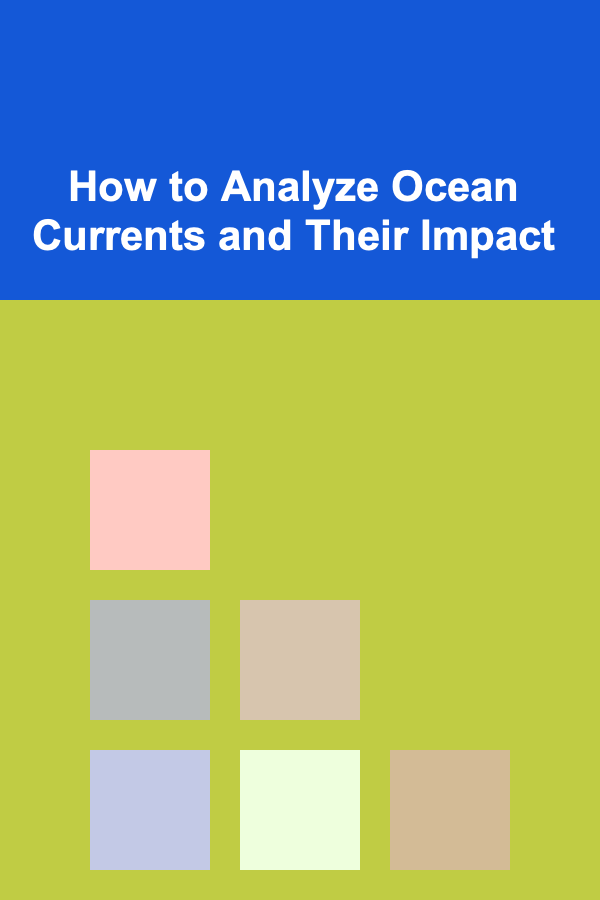
How to Analyze Ocean Currents and Their Impact
ebook include PDF & Audio bundle (Micro Guide)
$12.99$5.99
Limited Time Offer! Order within the next:

Ocean currents are one of the most important aspects of Earth's climate system. They play a vital role in regulating global temperature, distributing nutrients, and supporting marine ecosystems. Furthermore, they are integral to the movement of heat and moisture around the planet, influencing weather patterns, atmospheric circulation, and even human activities like shipping and fishing.
This article explores the various ways ocean currents can be analyzed, the methodologies employed in such analyses, and their far-reaching impacts on both natural and human systems.
Understanding Ocean Currents
Ocean currents refer to the continuous movement of seawater in a specific direction within the world's oceans. They can be classified into surface currents, which occur in the upper 400 meters of the ocean, and deep-water currents that are driven by temperature and salinity differences, known as thermohaline circulation.
Ocean currents are primarily caused by several factors:
- Wind: The wind is the primary driver of surface currents. Trade winds, westerlies, and polar easterlies push water across the ocean's surface, creating currents.
- Earth's Rotation: The Coriolis effect, caused by Earth's rotation, deflects the path of moving water to the right in the Northern Hemisphere and to the left in the Southern Hemisphere, resulting in circular patterns known as gyres.
- Temperature and Salinity: Water density changes with variations in temperature and salinity, creating deep-water currents. Colder, saltier water is denser and sinks, while warmer, less saline water rises.
- Topography: The shape of the seafloor, including underwater ridges and continents, affects the direction and strength of ocean currents. Ocean basins and coastlines shape the flow of water and can lead to upwelling or downwelling.
- Tidal Forces: Gravitational forces exerted by the moon and sun create tidal movements in the ocean. While tides are distinct from regular currents, they can interact with them and influence their behavior.
Methods to Analyze Ocean Currents
Analyzing ocean currents involves a combination of direct measurement, satellite observations, and computational models. Here, we look at the key methods used by oceanographers and climate scientists.
1. Direct Measurement Using Drifters
One of the most straightforward ways to track ocean currents is by deploying surface drifters. These are devices that float on the surface of the ocean and move with the current. Equipped with GPS and sensors, drifters provide valuable data on the speed, direction, and changes in current patterns over time.
- Advantages: Drifters provide real-time data and can be deployed in areas that are difficult to reach by ships or research stations.
- Limitations: While drifters provide valuable surface-level data, they are not capable of tracking deeper currents, which are also essential to understanding ocean dynamics.
2. Satellite Altimetry
Satellites can measure sea surface height, which is an indicator of ocean currents. When water moves due to currents, it alters the sea surface height. Satellites use radar to detect these changes, allowing scientists to observe surface currents across vast areas of the ocean.
- Advantages: Satellite altimetry provides large-scale, global data, which is essential for understanding the movement of ocean currents in remote areas.
- Limitations: Satellite measurements are limited to the surface and do not provide information about deeper currents or detailed measurements of water properties.
3. Argo Floats and Profilers
Argo floats are a key technology for studying deep-ocean currents. These are autonomous devices that travel through the ocean, collecting data on temperature, salinity, and depth. By analyzing how these floats move through different layers of the ocean, scientists can understand vertical currents and the broader system of thermohaline circulation.
- Advantages: Argo floats provide valuable vertical profiles and are capable of reaching depths of up to 2,000 meters, allowing for a more comprehensive analysis of ocean currents at various depths.
- Limitations: These floats are expensive and are typically deployed in specific locations, meaning that coverage is not global, and there are gaps in data collection.
4. Numerical Ocean Models
Numerical models are computational tools that simulate the behavior of ocean currents based on equations of fluid dynamics. These models can predict how currents will behave under different conditions and can be used to forecast their impact on regional or global scales.
- Advantages: Numerical models can integrate various factors, such as wind, temperature, salinity, and topography, to simulate and predict the movement of ocean currents under different scenarios.
- Limitations: These models rely on accurate data inputs and can be computationally expensive, requiring advanced supercomputing capabilities.
5. Current Meters
For localized measurements of ocean currents, oceanographers often use current meters. These instruments measure the speed and direction of water flow at specific depths. Current meters can be deployed at various depths to study the dynamics of both surface and deep currents.
- Advantages: Current meters provide detailed, in-situ data and can be used to monitor specific areas, such as coastal regions or oceanic eddies.
- Limitations: They are typically stationary, so they cannot measure large-scale or long-term changes in ocean currents.
6. Ship-based Observations
Researchers also collect data on ocean currents by sailing research vessels through the ocean. By measuring the movement of water using instruments such as Acoustic Doppler Current Profilers (ADCP), scientists can track currents along a specific transect or route.
- Advantages: Ship-based observations provide a wealth of detailed, high-resolution data and can be focused on specific regions or currents of interest.
- Limitations: This method is limited by the availability of ships and the difficulty of reaching remote ocean areas.
The Impact of Ocean Currents
Ocean currents play an integral role in regulating global climate, supporting marine life, and influencing human activities. Their impacts are vast and wide-reaching, affecting everything from weather patterns to economic industries.
1. Climate Regulation
Ocean currents are a key component in Earth's climate system. The movement of warm water from the equator to the poles and cold water from the poles to the equator helps to regulate global temperatures and balance the Earth's heat budget.
For example, the Gulf Stream, a warm ocean current in the North Atlantic, helps to moderate temperatures in Western Europe, keeping them much warmer than they would be otherwise. Conversely, cold ocean currents in regions like the Southern Ocean contribute to cooling nearby landmasses.
Changes in ocean currents, whether natural or induced by climate change, can have profound consequences on weather systems, potentially leading to shifts in rainfall patterns, increased storm intensity, or even changes in the distribution of ecosystems.
2. Marine Ecosystems
Ocean currents play a critical role in the distribution of nutrients throughout the ocean. Upwelling, the process by which cold, nutrient-rich water rises to the surface, is driven by currents and is essential for supporting productive ecosystems.
These currents also help disperse larvae, plankton, and other marine organisms, influencing the distribution of species. For example, the California Current, which flows along the U.S. West Coast, supports a rich marine ecosystem that sustains one of the most productive fisheries in the world.
3. Navigation and Shipping
Shipping and navigation are heavily influenced by ocean currents. Currents can either help or hinder ships in their journeys. For example, ships traveling with the Gulf Stream may save time and fuel, while those going against it may experience slower travel times and increased fuel consumption.
Understanding ocean currents is crucial for efficient shipping, especially in areas with strong currents like the Strait of Gibraltar or the waters around Cape Horn.
4. Human Impact and Global Warming
Ocean currents are also affected by human activities, especially climate change. Rising global temperatures and melting ice caps can alter the strength and direction of major currents like the Gulf Stream or the Antarctic Circumpolar Current.
Increased greenhouse gas emissions and land-based pollution can also disrupt the delicate balance of oceanic systems, resulting in changes to marine life distribution, more frequent storms, and even sea-level rise.
Changes in ocean circulation could also have a profound impact on coastal cities, ecosystems, and agriculture, making the analysis of ocean currents and their impacts more important than ever.
5. Fisheries and Marine Resources
The movement of ocean currents directly impacts the abundance and distribution of marine resources. Fisheries around the world are highly sensitive to changes in ocean currents, which can affect the availability of fish and other marine organisms.
For instance, the El Niño phenomenon, which disrupts normal ocean current patterns in the Pacific, can result in significant shifts in fish populations, impacting global fish stocks and the economies that rely on them.
Conclusion
The analysis of ocean currents is critical to understanding the complex interdependencies that define Earth's climate system. From regulating temperature to supporting marine life, ocean currents influence numerous aspects of life on our planet. With advanced technologies like satellite altimetry, numerical models, and direct observations, scientists continue to improve our understanding of these currents and their impact on the world around us.
As the climate changes and human activities further alter the balance of natural systems, the study of ocean currents will become increasingly important for forecasting and mitigating their effects. In the future, more comprehensive and integrated approaches to monitoring ocean currents will be needed to ensure that we can maintain the delicate balance that sustains life on Earth.

How to Declutter Your Backyard Before Summer
Read More
How to Decorate Your Home Using Only Budget-Friendly Furniture
Read More
How to Keep Track of Expiration Dates in Your Pantry
Read More
How to Organize Your Gardening Journal for Better Planning
Read More
How to Sort and Store Holiday Decorations
Read More
Mastering Water Purification in the Backcountry: A Comprehensive Guide
Read MoreOther Products

How to Declutter Your Backyard Before Summer
Read More
How to Decorate Your Home Using Only Budget-Friendly Furniture
Read More
How to Keep Track of Expiration Dates in Your Pantry
Read More
How to Organize Your Gardening Journal for Better Planning
Read More
How to Sort and Store Holiday Decorations
Read More